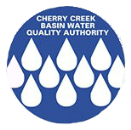Nutrients Depth Profile
During WY 2018, the Authority collected nutrient samples through the water column at CCR-2. Total phosphorus (TP) concentrations generally increased with depth. TP concentrations were elevated in the hypolimnion (lower layer of water in a stratified lake) from early spring through summer. Phosphorus increases in the hypolimnion can be caused by internal loading or result from the decomposition of algal cells and other organic matter settling from higher levels in the water column. Inflows of cold runoff water, which has a higher density than warmer, surface waters and sinks to the bottom as in enters a lake, can also directly increase hypolimnetic nutrient concentrations, especially in reservoirs.
Total phosphorus is made up of both particulate and dissolved phosphorus. Particulate phosphorus includes both inorganic material, such as soil particles and clay minerals, and organic phosphorus, which includes particulate forms such as algal cells and plant fragments. Total dissolved phosphorus (P-Diss) includes dissolved organic and inorganic material. Dissolved inorganic phosphorus is usually reported as soluble reactive phosphorus (SRP), which represents the bioavailable form of phosphorus.
During WY 2018, total nitrogen (TN) levels were elevated throughout the water column during the April 26th and July 10th and 23rd monitoring events. These events correlate with two of the monitoring events where samples collected at 7 m had values of TP that were also elevated.
Useful Links

Nutrients Depth Profile
info_outlineEach square on this depth profile represents a sampling event. The different square colors represent the magnitude of the the value for the a sampling event. To learn more about a specific data point, hover over a square with your mouse.
Hey! This page is interactive.
- Change the start and end dates to look at different time periods
- Investigate different parameters using the parameter dropdown list
- View different locations using the surface water location list
- To learn more about a specific data point, hover over a square with your mouse.
